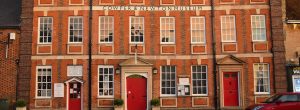A box, but a very special box. It is Cowper’s portable writing box, which opens up to become a miniature desk. This ‘writing slope’, to give it its correct designation, dates from around 1790. It was part of a collection of Cowper memorabilia that had passed by descent to the Cowper Johnson family, and purchased by the Museum in 2006.
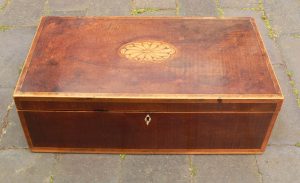
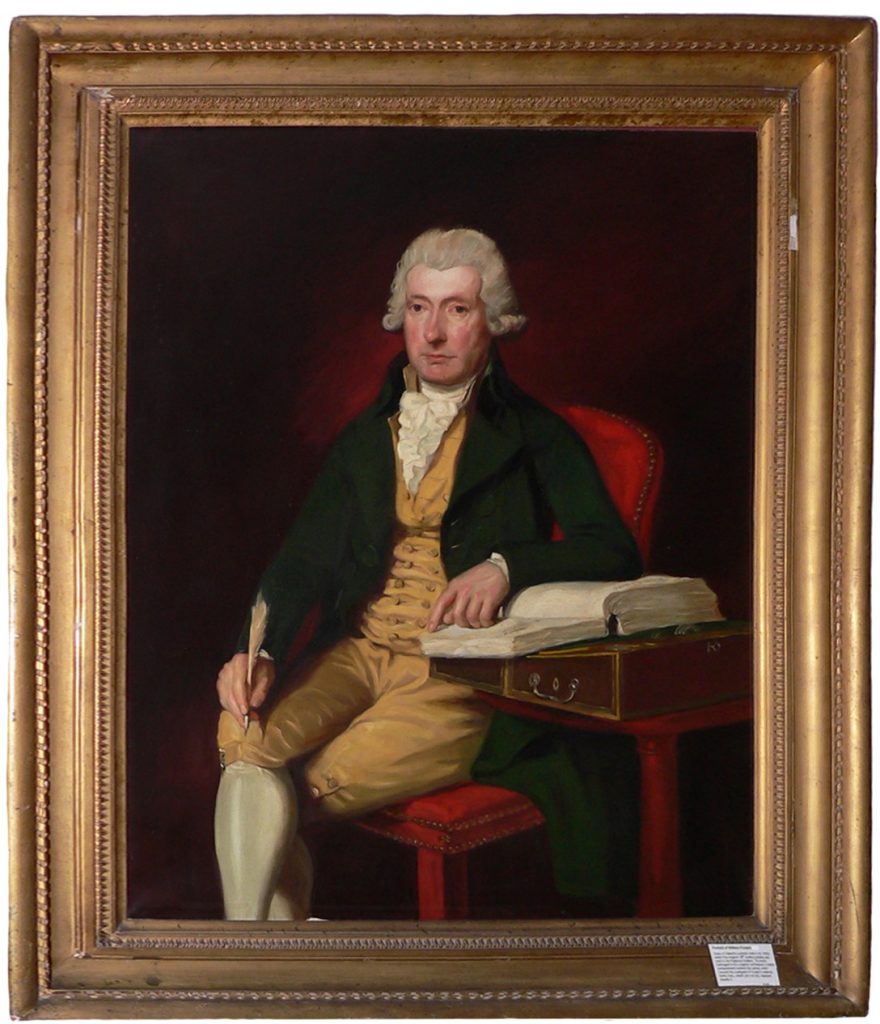
The portrait of Cowper with his box
There is a portrait of Cowper hanging in the hall of the museum which depicts him seated by this special desk. The painting is worth comment for the glimpse it gives us of Cowper the writer and of some of the tools of his trade, including, importantly, our writing slope.
The portrait is a copy of one painted by Abbott in 1792 (the original was bought by the National Portrait Gallery). Lemuel Francis Abbott was a largely self-taught painter, famous for his ability to capture a good likeness of his sitters – particularly their facial expressions. It had been commissioned by John Johnson – a second cousin of Cowper’s from his mother’s side of the family – as a present for his aunt Mrs Anne Bodham. Johnny, as he was usually known, was by all accounts a vivacious, bubbly relation, but Cowper had lost touch with his Norfolk- based maternal family and the two only met in 1790. Johnny was 19 at the time, but the two got on famously:
Johnny, with whom I have been always delighted, is also so much in love with me, that no place in the world will suit him to live at present, except Weston [Underwood].
Johnny became a devoted friend, admirer and frequent visitor.
We don’t know for sure what Cowper thought of the portrait project at first, but he seems to have warmed to it, and to Abbott, as work progressed:
I have sat twice, and the few who have seen his copy of me are much struck with the resemblance. He [Abbott] is a sober quiet man, which considering I must have him at least a week longer for an inmate, is a great comfort to me.
And a little later, he wrote to Lady Hesketh, with rather more enthusiasm but with his typical dryness:
My portrait is nearly finished. An excellent one in my mind and in the opinion of all who see it, both for drawing and likeness… Should it be your wish to view it…I think it will afford you as much pleasure, nay perhaps even more, than a sight of the original myself; for…while this picture subsists, my charming lineaments and proportions can never be forgotten.
To his friend the Reverend William Bull of Newport Pagnell, he also joked about his ten days of
…sitting. Not on cockatrice eggs, nor because I was too sick to move …but because my Cousin Johnson has an Aunt who has a longing desire for my picture…
He goes on to make it clear how impressed he is with the result:
The likeness is so strong that when my friends enter the room where the picture is they start, astonished to see me where they know I am not…
…this prodigy of art goes to London next Monday to be suspended a while at Abbott’s, and then proceeds onto Norfolk where it will be suspended for ever.
With such acclaim from the sitter, we should perhaps look more closely at the portrait to see what this ‘likeness’ and other elements in the composition might tell us about the man, his work and even his writing slope.
In the painting Cowper is shown seated on a smart red upholstered chair. He has a strong posture – a good, upright back – and is placed centrally on the canvas, his body almost filling it. He is sitting slightly above us and from this raised position stares us straight in the eye. Posed in this way, Cowper has a quietly authoritative air, suggestive of a serious man of some considerable importance; and it’s an effect enhanced by the objects selected to be painted along with him.
Following a long-standing convention in portraiture, Cowper is depicted with his attributes – objects that identify a sitter and, usually, celebrate his or her achievements. He points with the forefinger of his left hand at a vast tome, while in his right he holds a quill pen.

The book is his recently published translation of Homer’s Iliad and Odyssey, which Cowper intended as the crowning achievement of his literary career.. The pen he holds obviously represents an essential tool of the writer’s trade. The book is shown lying open on the writing slope. We can deduce that the box was an important personal artefact both from its inclusion in the painting and because Abbott has shown it performing a crucial role: it supports his book and, metaphorically, Cowper’s literary career – his reading and his writing.
Some twelve years earlier (probably in 1779, though the letter is undated) Cowper had evoked a similar picture in words, referring to another special box in which he stored his private papers. He metaphorically identifies his friend William (the son of Mrs Unwin, his constant companion at Orchard Side) with a box in which he could secrete some of his poetry.
You are my mahogany box with a slit in the lid of it, to which I commit my productions of the lyric kind, in perfect confidence that there they are safe, and will go no further. All who are attached to this Jingling Art have this peculiarity, that they would find no pleasure in the exercise, had they not one friend at least to whom they might publish what they have composed. If you approve my Latin, and your wife and sister my English, this, together with the approbation of your mother, is fame enough for me.
However valuable it was to him in his work, this mahogany box is very unlikely to be our writing slope; it was more probably a fairly ordinary rectangular box with a fitting in the lid that dropped open to hold papers. Indeed, as we shall shortly see, Cowper says he did not own a portable desk in 1785 (just six years on) but relied instead on makeshift piles of books and maps on which to rest his papers.
But back to the portrait for a moment. As in the letter just quoted, the indications are that it seeks to present Cowper as a modest man (or someone careful about being too proud).
We can infer this because, although the painting shows Cowper as a man of fashion (he sports yellow silk breeches and a matching waistcoat, both neatly finished with yellow silk buttons; he wears shimmering silk stockings and a very elaborate cravat) and in a quietly commanding pose, the portrait is not in other respects particularly imposing or grand. For instance, Cowper is seated and is apparently ‘at home’. He comes across as a private man comfortable in his own surroundings and ‘doing his own thing’, however important that was, rather than emphasising his celebrity status. If, on the other hand, he were standing and placed in an ostentatious setting, we might be more inclined to read the portrait as a public statement about Cowper’s social and literary pre-eminence.
We might therefore ‘read’ this picture of Cowper and his box as follows. The writing slope is a treasured and important possession supporting the work of a serious reader and writer; a gentleman who is of some social and literary position, well worthy of our respect, but at the same time accessible and modest in demeanor.
Cowper’s ‘Homer’
‘Homer’ was published in two volumes quarto in 1791. Here is the title page of John Johnson’s copy in the museum, with his ‘Ex Libris’ signature denoting his ownership. The second title page shown is from an octavo edition published in Dublin the following year.

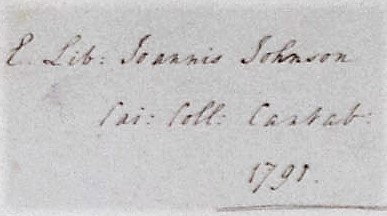
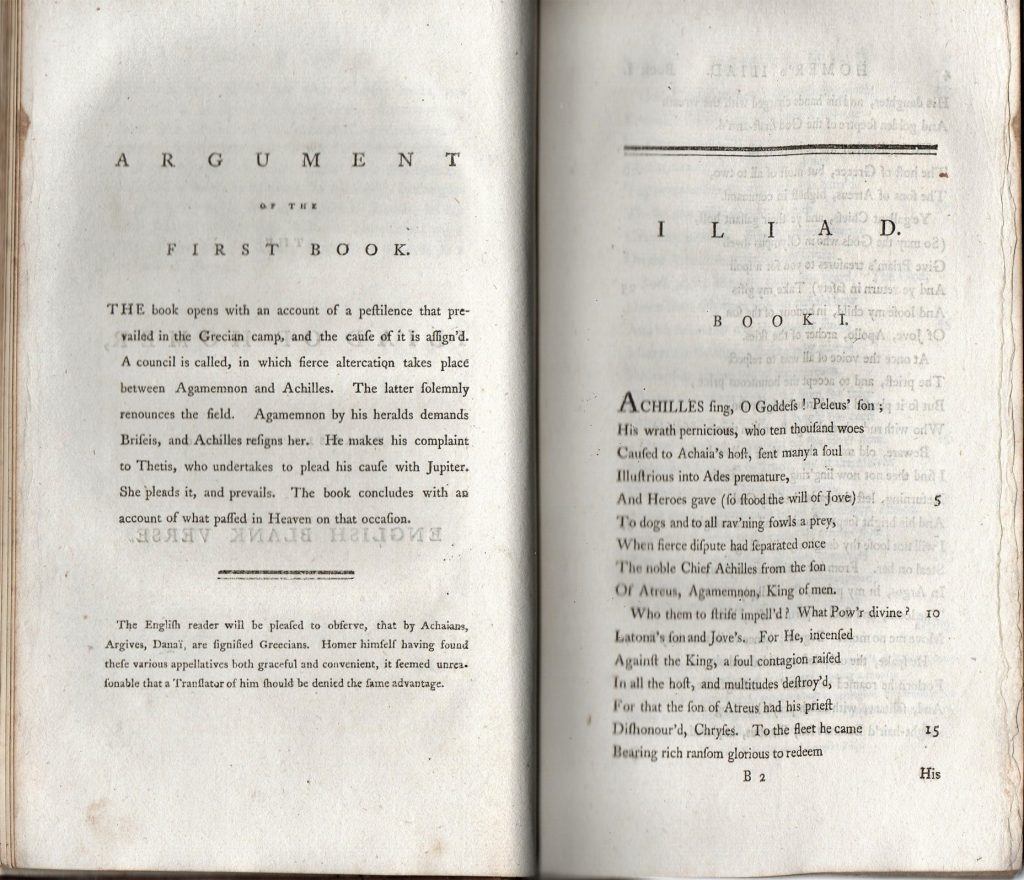
The Abbott portrait was painted the following year, 1792, so Johnny may have suggested including the Homer volume in it. Indeed, he could have commissioned the portrait partly to celebrate publication of the great work – even to promote it and the author. Johnson thought of having it engraved as the frontispiece to a new edition of Cowper’s poems which he planned to publish for Cowper’s benefit in 1792-3, but nothing came of this idea
The first edition was in the luxury quarto size (11.25 x 8.25 ins / 285 x 210 mm), for the wealthy, the second (1792) in the smaller octavo format (8.25 x 5 ins. / 210 x 127 mm), for a wider market. ‘The bulk of readers are those who purchase octavos; the rich only can afford quartos, and they read nothing’, as Cowper wrote to Lady Hesketh. The Dublin edition is in octavo, probably published simultaneously with, or soon after, the London edition in this format.
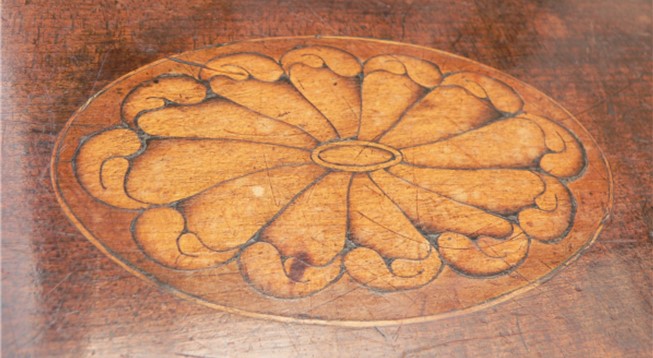
The writing slope – a close-up
The desk is made of attractively figured mahogany, banded in fruitwood and edged with box. The lid has a centrally placed, inlaid boxwood motif edged in fruitwood and rimmed with a further thin line of boxwood. The motif is an oval ‘patera’, a popular decorative design used on eighteenth-century furniture and in interior décor more generally. (A patera is a stylised image, usually leaf-like in form, of a shallow dish used in the ancient world for offerings.) The dark and light, three-dimensional effects on the patera – for example the shading on the scrolled edges of this leaf form – may have been achieved by scorching the inlaid wood; this was usually done by dipping the wood into hot sand or lead.

The lid of the box is hinged so that when fully open it lies flat, aligned with the base. The interior then forms a continuous, and reasonably smooth, writing slope. The surface of this incline is covered with some rather moth-eaten green baize. This may well be the original covering material (though the slopes of many such desks were covered in leather) as the slope in the portrait is also coloured green.To make this continuous writing slope, the wood has been cut very shallow at one end of the lid and then at a slant, rising through the central hinge to the far end of the box’s base.
At this, the highest point, there is a shelved recess, divided into compartments designed to hold various writing necessaries such as ink, pens, sealing wax and ‘pounce’ – a kind of sand or powder sprinkled over wet ink to dry it (this is before the invention of blotting paper). The glass pounce pot is still in its compartment, its pewter lid pierced, pepper-pot fashion, to allow the pounce to be shaken over the paper,
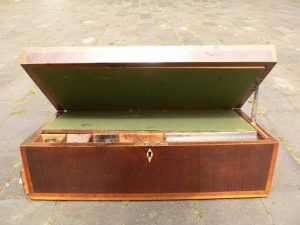
The lid of the slope can be held open, supported at various heights, by a narrow brass rod. This small brass mechanism normally lies flat, embedded in the edge of the base, but can be lifted and slotted into one of several small holes in the lid. In this mode, the desk becomes more like a lectern, a practical support for reading books at a comfortable angle.
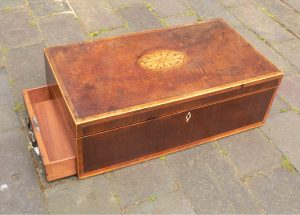
The desk has a side drawer for papers or other stationery, fitted with a brass swan-neck handle. This drawer is somewhat hidden, or disguised, in the side of the box – a feature that would seem to suit Cowper’s desire to hide away some of his ‘jingling art’ until perhaps he felt more sure of its quality. On the other side of the base there is a matching handle; when the box is closed the coming together of the two makes it easy to carry.
Other such desks
Portable writing desks had been known for many centuries and in many countries before they became fashionable in England. They became popular here in the third decade of the eighteenth century, not just as a fashionable item but also for their usefulness. This was in the context of a newly demanding intellectual, social and business world. Such boxes were efficient and versatile, supporting the work of the creative writer and researcher as well as that of the business man or inquisitive traveller.
Indeed, in the late eighteenth century they might be found in drawing rooms or libraries, with military men on their expeditions and amongst travellers’ luggage. They might be laid on table top or lap and used to support the composing or reading of many kinds of document – private diaries and correspondence, semi-public business contracts, and manuscripts intended for publication. They also made elegant statements, for they were well-made pieces of miniature furniture.
 It’s important to note though, that unlike a desk or table, a writing box was definitely a personal, not a household, or shared possession. In our case, this was definitely Cowper’s private box. He had a key for it, so could keep it locked, and could secrete special papers away in it; this was not a piece of furniture made for general use.
It’s important to note though, that unlike a desk or table, a writing box was definitely a personal, not a household, or shared possession. In our case, this was definitely Cowper’s private box. He had a key for it, so could keep it locked, and could secrete special papers away in it; this was not a piece of furniture made for general use.
Myths and mysteries: a second writing slope
Until recently the museum believed that the mahogany slope discussed above was one given to Cowper by his cousin Harriot, Lady Hesketh, in December 1785. There is a handwritten note in the drawer of the little desk, thought to have been supplied by one of the Cowper Johnson relatives, which makes this claim. The writer of the note also says it is the box depicted in the Abbott portrait, and adds that Cowper is believed to have written his famous poem, The Task, on it.
Sadly, most of this turns out to be a myth – the only true part being that this desk is the one depicted in Abbott’s portrait. But such is the magical power of a handwritten note from a Cowper relative that the claim remained unchallenged until 2011.
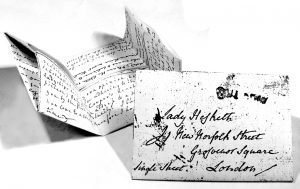
As it happens Cowper was given a writing slope by his cousin Harriot, Lady Hesketh in the winter of 1785. (In fact Harriot, it turns out, was acting for her sister Theadora, from whom the gift really came. But for simplicity’s sake we will call it Harriot’s box.) And we know from Cowper’s ‘thank you’ letter to Lady Hesketh that it was an object he particularly loved:
My desk, the most elegant, the compactest, the most commodious desk in the world, and of all the desks that ever were or ever shall be, the desk that I love the most, is safe arrived.
(This extract is quoted in the note written by Cowper’s relative as if to prove we are talking about the same desk.) But we can also read, in a letter from Cowper to William Unwin written only a couple of weeks later, a nice description of the ‘Harriot Desk’. It sounds splendid and Cowper is clearly thrilled with it:
Let me sing the praises of the desk my dear cousin has sent me. In general it is as elegant as possible. In particular it is of cedar, beautifully lacquered. When put together it forms a handsome small chest, contains all sorts of accommodations, is furnished with cut glass for ink and sand, and is hinged, handled and mounted with silver. It is inlaid with ivory, and also serves the purpose of a reading desk. It came with stationery ware of all sorts, and this splendid sheet is part of it.
These details reveal that Cowper must have describing another desk, for there is no silver or ivory, lacquer or cedar wood to be seen on our mahogany version. He had bad eyesight but he could hardly have been that mistaken. What is also interesting is that he cannot have owned our mahogany desk when he received Harriot’s precious gift, because while anxiously waiting for it to be delivered – he knew of its impending arrival – Cowper wrote to her:
…Where can it possibly be? I am not absolutely in despair about it…but to tell the truth I stand tottering upon the verge of it. I write, and have written these many years, upon a book of maps, which I now begin to find run too low and too flat, though till I expected a better desk, I found no fault with them. See and observe how true it is, that by increasing the number of our conveniences, we multiply our wants exactly in the same proportion!
As noted earlier, Cowper had devised his own way of supporting his work and it didn’t apparently involve a wooden desk of any sort. The sequence of his ownership of portable desks is puzzling: until late in 1785 he was apparently accustomed to writing on a slippery pile of maps and owned no desk at all; in December of that year he was given a fancy desk by Harriot; but by 1792, when the portrait was painted, he seems to have abandoned this splendid gift in preference for the mahogany one the museum now owns. Moreover, we have no further knowledge of the Harriot desk – it isn’t mentioned again in his correspondence, nor does there appears to be any reference to the mahogany slope in the Abbott portrait.
Did he own two writing slopes? If so, when did he acquire the second mahogany box and why did he choose to have it appear in the Abbott portrait rather than the more exotic-sounding one from Harriot? Indeed, what happened to this much-loved ivory, silver and cedarwood concoction? Was the mahogany box ‘with a slit in the lid’, described in his letter to William Unwin, perhaps an early reference to our writing slope after all?
One thing we can say with some confidence: Cowper cannot have composed The Task on a desk he does not seem to have owned when that poem was completed, in 1784.
Such is the lure of a good story about provenance – and there are many such uncurling themselves in the museum world – that myths soon ossify into fact. But in the process a fascinating new set of questions often emerges. And in this case we have to ask – what IS the true story behind our mahogany box?
Cowper and publication
We started by looking at Cowper’s writing slope from the perspective of its inclusion in the Abbott portrait, and by considering what the content of the painting suggested about the man and his work. We thought it depicted a rather private public man; one who seemed reluctant to shout about his considerable literary standing – this we considered was a relatively homely portrait – but of someone who nevertheless chose to be represented as a man of letters, whose identity seemed bound up with reading and writing, as if these were the most important things about him. But, and at the same time, we saw someone who did not seem to want to exaggerate his greatness as a writer or as a public figure. The portrait might have left us wondering how much Cowper would ever really want to be in the public eye and by extension how much he would want his work to be published.
And so we end by returning to this idea, to take a brief look at what Cowper said about his own writing; what he claimed for it, how he judged it, and what he wanted for it. It is interesting to notice how his ideas develop over time.
Here he is on the pleasure he takes from writing and, by implication, what he values about it. He is writing to William Unwin in 1779.
No manufacturer of waking dreams ever succeeded better in his employment than I do, I can weave such a piece of tapestry in a few minutes, as not only has all the charms of a reality, but is embellished also with a variety of beauties, which tho’ they never existed, are more captivating than any that ever did.
He went on, in another letter to William of that year, to comment on his poetry, and does so again in very humble vein.
You I think was never a dabbler in Rhime; I have been one ever since I was 14 years of age, when I began with translating an elegy of Tibullus. I have no more right to the name of poet than a maker of mousetraps has to that of an engineer, but my little exploits this way have at times amused me so much, that I have often wished myself a good one. Such a talent as mine is like a child’s rattle, very entertaining to the trifler that uses it, and very disagreeable to all beside.
Note the reference to ‘amusement’, a motivation Cowper often mentions in relation to his writing. At first it is all he claims for this way of occupying his time, but as he grows in fame and confidence he tends to shift his ground.
We begin to see the change in 1781. In a letter to John Newton he says he wants his work to be ‘useful’ to others, and (dare he say it?) ‘approved’ by them, as well as being a private pleasure.
No man ever wrote such quantities of verse as I have written this last year, with so much indifference about the event, or rather with so little ambition of public praise. My pieces are such as may possibly be made useful. The more they are approved, the more likely they are to spread, and consequently the more likely to attain the end of usefulness, which as I once said before, except my present amusement is the only end I propose.
By this time he has also started to comment on how careful a writer he is and to point up, with some mild pride, that he is not just having casual fun, but is a disciplined craftsman with a proper concern for the technicalities of his trade. (This concern extended to his letter writing, where we may note, for example, his insistence that a hand-written page should look well-crafted, tidy and all of a piece.) As he says in another letter,
Whatever faults I may be chargeable with as a poet, I cannot accuse myself of negligence – I never suffer a line to pass till I have made it as good as I can.
But he still hesitates to claim that he is a serious writer:
The moment a man takes it into his foolish head, that he has what the world calls genius, he gives himself a discharge from the servile drudgery of all friendly offices, and becomes good for nothing except in the pursuit of his favourite employment. But I am not yet vain enough to think myself entitled to such self-conferred honors.
Eventually Cowper has to face the growing dilemma he has about his writing. Is it still just a private, albeit disciplined, amusement and diversion or is it something the world at large should see? On the whys and wherefores of ‘going public’, he tells Newton,
If a Board of Enquiry were to be established at which poets were to undergo an examination respecting the motives that induced them to publish, and I were summoned that I might give an account of mine, I think I could truly say, what perhaps few poets could – that though I have no objection to lucrative consequences if any such should follow, they are not my aim; much less is it my ambition to exhibit myself to the world as a genius. What then says Mr. President, can possibly be your motive? I answer with a bow – amusement; there is nothing but this, no occupation within the compass of my small sphere, poetry excepted, that can do much towards diverting that train of melancholy thoughts, which when I am not thus employed, are for ever pouring themselves in upon me. And if I did not publish what I write, I could not interest myself sufficiently in my own success to make an amusement of it.
From this letter it seems that, for Cowper, publishing added a necessary element of risk, gave an edge to an otherwise trivial amusement, one that he could only value as a diversion and a temporary (albeit valuable) cure for his bouts of depression. And the risk came from minding what others thought of his work.
He is clear about the life-giving energy, the essential ‘push’ to authenticity, that going public and facing criticism could give a creative writer:
You are sensible that it is not an age in which poetry of a religious or moral tendency is likely to find many readers. But I know well that publication is necessary to give an edge to the poetical turn, and that what we produce in the closet, is never a vigorous birth, if we intend that it should die there. For my own part, I could no more amuse myself with writing verse, if I did not print it when written, than with the study of tactics for which I can never have any real occasion.
Finally, here he is writing to his cousin Harriot in 1786, talking again about whether, or why, he should publish his work. It’s the ‘shall I shan’t I?’ Cowper we saw in the portrait, admitting to a little ambition after all, but not wanting to make too much noise:
I am not ashamed to confess that having commenced as an author I am most ardently desirous to succeed as such. I have, what you perhaps little suspect me of, in my nature an infinite share of ambition. But with it as you well know an equal share of diffidence. To this combination of opposite qualities it has been owing that till lately I stole through life without undertaking anything, yet always wishing to distinguish myself.
It’s the ultimate confession of the man we saw in the painting – a shyly distinguished Cowper with his writing slope; quietly going public, and probably rather pleased to have taken this daring step.
As he wrote to Johnny Johnson when the portrait was about to be shown more widely,
After having been exhibited in his [Abbott’s] room so long, I care not where I am exhibited next. The public at large are welcome to a sight of me, if he and you and they are agreed upon it.
More on writing
In another article, on Cowper’s letter cabinet, we examine his letter writing, some of the other writing accessories he used, and the complex workings of the postal system he had to rely on.
Further reading
Harris, David, Portable Writing Desks, Shire, 2000.
Mell, George, Writing Antiques, Shire, 2010.
Cowper, William, The Iliad and Odyssey of Homer, 1791
Jane Austen also owned a similar writing slope which is now part of the British Library collection. ‘My father reads Cowper to us in the morning, to which I listen when I can.’ Jane Austen, December 1798



